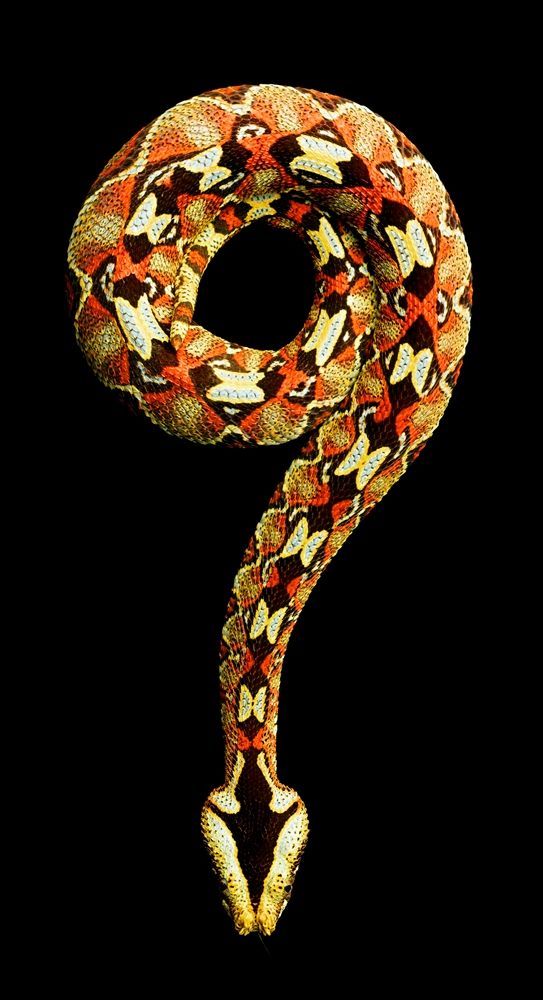

They may live 15 – 20 years in captivity. Newborns average 10 inches and are completely on their own from birth. Large females have been known to deliver as many as 60 in one batch, but they do not normally breed every year. Breeding usually takes place during the dry season and the snakelings are born during the rainy season. Eggs are held within the body until hatching time. Gaboons, like most vipers, are ovoviviparous. The object is to push the opponent to the ground and the winner pushes the other male’s head down while elevating his own into the air. Equally matched males can and do wrestle for extended lengths of time, even breaking off to rest before resuming the contest. Combatants will inter-twine their necks and fore-bodies, but they do not rise vertically as much as other vipers do. Male Gaboons that meet up, while in pursuit of a female, will engage in a viper wrestling match. The exceptions, especially for smaller young snakes, are Secretary Birds ( Sagittarius serpentarius), large snake-eating snakes and, possibly, large monitor lizards. Their camouflage works so well, and, with their size and lethal venom, few predators bother the adults.

The Gaboons have the longest fangs (big specimens often have fangs 2 inches long), and highest venom yield of any venomous snake. Typical of vipers, the fangs are too long for the closed mouth and fold up against the roof of the mouth when not in use. Tongue-flicking is, of course, absent also.Ī disturbed Gaboon will sometimes rear up, hiss and “yawn” to display its fangs, but it usually freezes and lets its camouflage do the work. When sleeping, the eye-motion stops and the vertical-slit pupils close as far as possible. Interestingly, the South American Bushmaster ( Lachesis muta) does the same thing.įor some reason, these snakes move their eyes much more than most snakes, and their eyes have a rather large range of motion. Unlike most vipers, Gaboons do not release the prey after the strike. They are seldom aggressive, but their strike is swift and the bite is extremely serious. They are considered slow-moving, mature snakes moving mostly by rectilinear “rib-walking” as seen in big boas and pythons. They are known to actively hunt in grasslands and plantations near a forested area, if there is livestock or crops and the possibility of rats. Gaboon Vipers are nocturnal, ambush predators, well adapted to hiding in leaf litter. The pattern is very similar to the Rhinoceros Viper, but generally less intense in color.
#BLUE RHINOCEROS VIPER PATCH#
Patch colors may be silver, purple, blue, yellow, black, gold, even red. One thin one angled slightly back and a wider one to the corner of the jaw. One pencil-line marks the center of the head. The intricate pattern involves thin pencil-lines of black that seem to block in many of the subtle triangular and rectangular color splashes. Gaboons have a ground color of silver-gray to tan. Even if one does not like snakes, most would admit to the beauty of that pattern. Wild – Gaboons eat ground birds like doves, rodents, mongoose and hares (rabbits).In either part of their range, they are occasionally in swampy areas or places with shallow, slow-moving water. Gaboon Vipers are primarily found in rainforest and closed-canopy woodland of western Africa, but very often in secondary thickets and brush of gallery forests and neighboring plantations (like cashew and coffee), in its much-more limited eastern African range. Mature females are usually larger than males. A large, healthy specimen can weigh 25 pounds. The longest fangs measured were 2.3 inches.

The fangs are the longest, relatively, of any venomous snake. They have the typical viper-triangle head (which, in large snakes may be 6 inches across), with a blunted muzzle and wide-set jaw bones, accommodating the large venom glands and making the back of the head obviously wider than the neck. They are the heaviest of snakes for their length. Gaboons are big snakes, made bigger by their body bulk. rhinoceros, with larger horns and one triangle under each eye.

gabonica, with small horns and two triangles under the eyes, and the Western, B. There are 2 subspecies of Gaboon, the Eastern, B. The Gaboon is sometimes called Gabon Viper because the “type” locality (the place where it was found) is in the country of Gabon, western Africa. Sometimes called “Rhinoceros Viper” (because of a pointed, horn-like scale on the tip of the rostrum), this species is not to be confused with its close “cousin” Bitis nasicornis, the Rhinoceros Viper, which has 2 to 4 large, thorn-like “horns” on its rostrum.


 0 kommentar(er)
0 kommentar(er)
